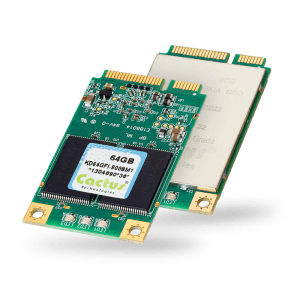What is a mSATA SSD Drive?
 mSATA is a small form factor flash storage device which is used like a hard disk drive in a host computer system. The host system must have a specific connector for the mSATA drive to be inserted. As with other flash storage devices, the mSATA can be used to store operating systems, applications and other data.
mSATA is a small form factor flash storage device which is used like a hard disk drive in a host computer system. The host system must have a specific connector for the mSATA drive to be inserted. As with other flash storage devices, the mSATA can be used to store operating systems, applications and other data.
Both the SATA-IO Group and JEDEC define and publish standards for the mSATA form factor. The mSATA SSD drive is relatively small at 50.8mm x 29.85mm and delivers a lot of capacity in this small footprint. Depending on the product, it can support one or all three SATA interface specification from 1.5Gbits/sec to 6.0Gbits/sec performance.
Whether the requirement is for an industrial or commercial application, the mSATA has a solution.
Cactus has an Industrial mSATA, which uses the much higher reliability SLC NAND flash. This is for applications where the system will be used in a high workload environment or in extreme environmental conditions.
Another advantage of Industrial mSATA is their longevity. Industrial flash storage devices have life cycles of greater than 5 years in many instances. This means only one qualification is required since production units are built using the same Bill-Of-Material for many years.
All the advantages of the Industrial mSATA come at a premium selling price. The memory and controller technology needed to meet the high specifications are expensive. This makes the Industrial mSATA significantly more expensive than the mainstream mSATA.
For applications requiring a cost effective solution for less demanding applications, Cactus offers our Industrial MLC mSATA based on the lower cost MLC NAND flash memory.
These MLC mSATA products are used in mainstream notebooks, tablets and some embedded applications. Cactus offers up to 128GB mSATA in our Industrial MLC 220S Series product line.
While there is a lower cost associated with mSATA devices built with MLC NAND memory, they come with lower endurance or number of write cycles per logical block. The products also have a shorter life span of 18-24 months before transitioning to the next geometry of NAND flash.
There are a number of other items to consider when making your selection of flash memory form factor, industrial or commercial grade and flash storage vendor. We’d be happy to discuss any specific items you make have. Just contact us.






